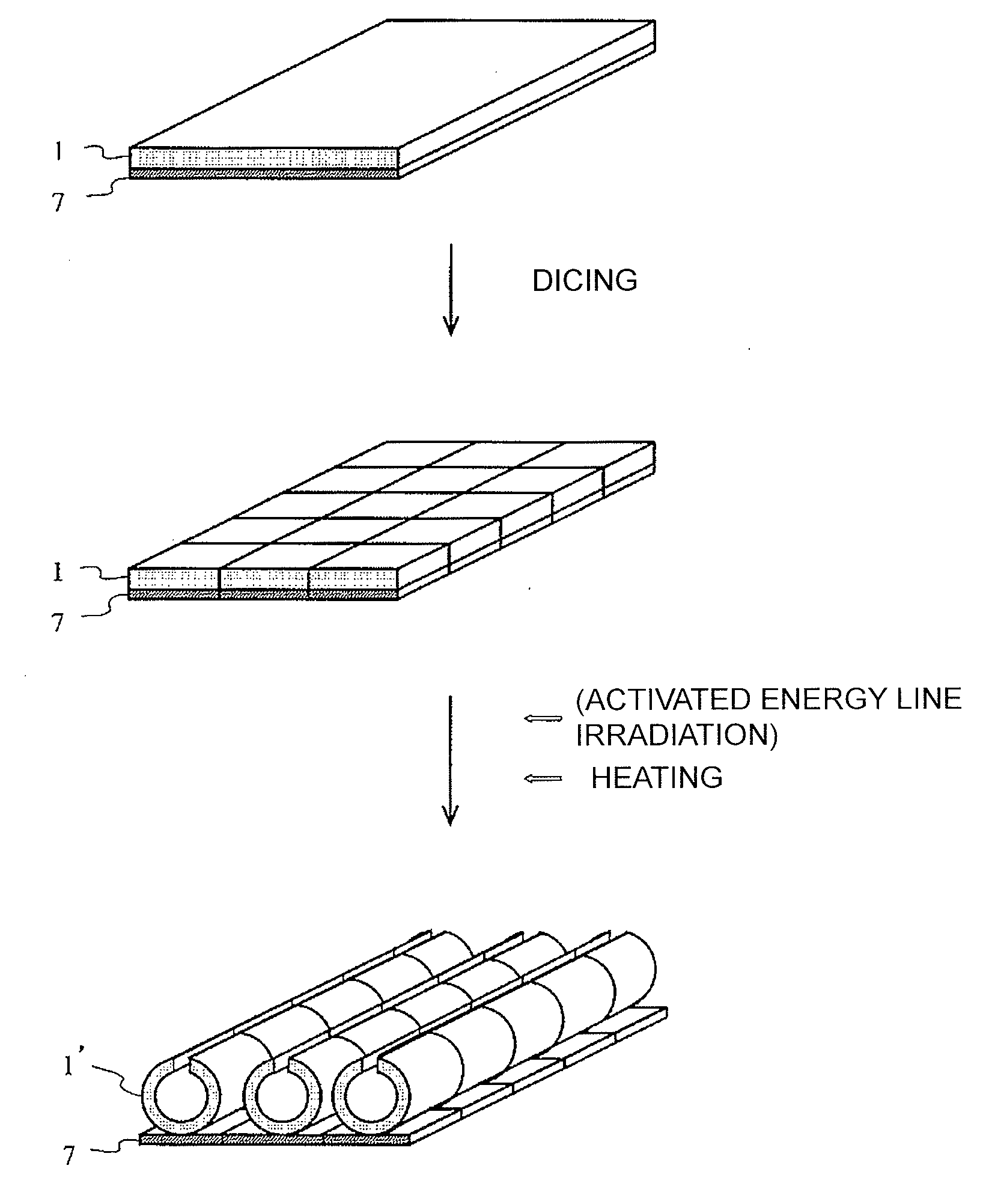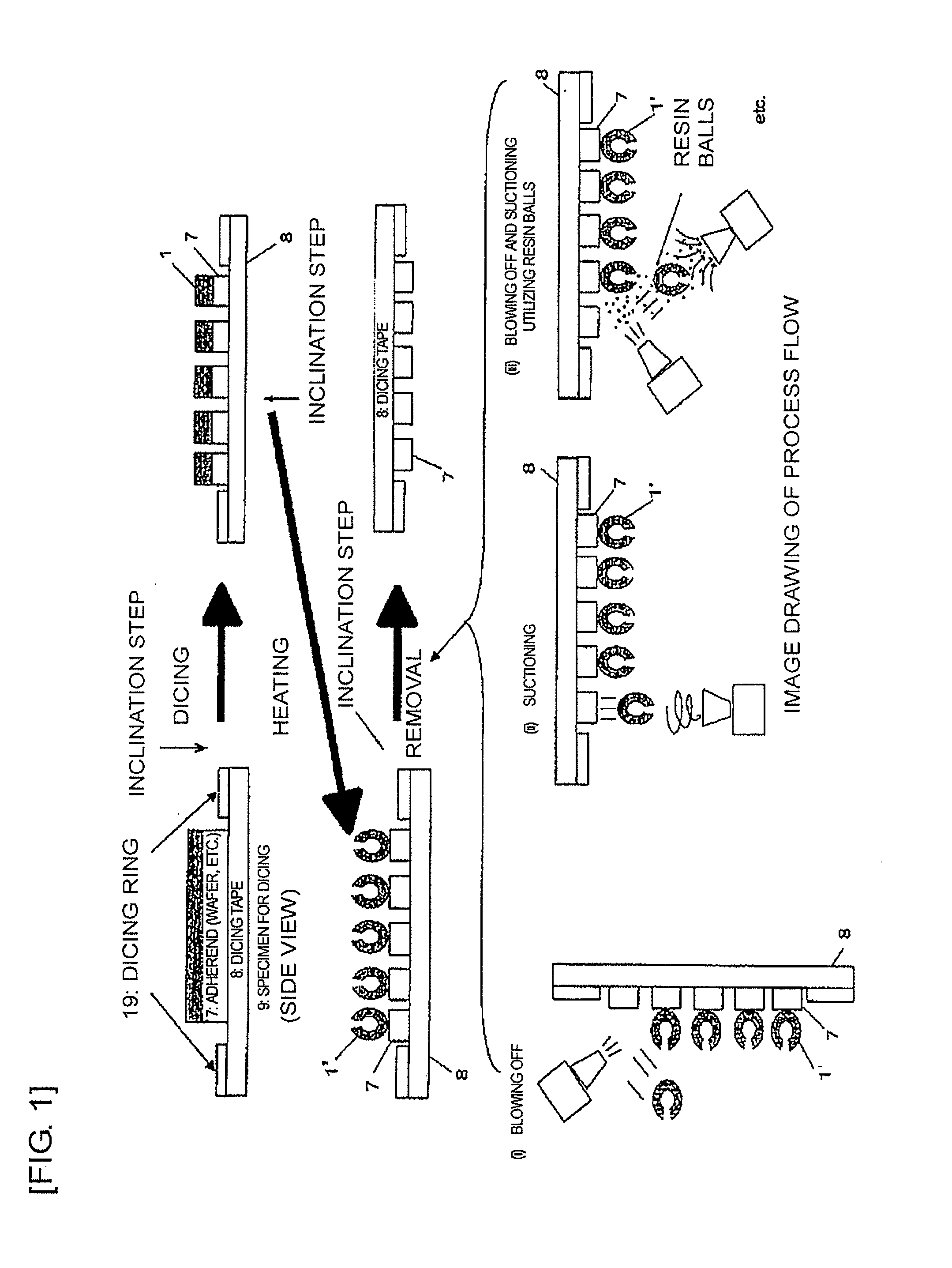Method for separating and removing dicing surface protection tape from object to be cut
- Summary
- Abstract
- Description
- Claims
- Application Information
AI Technical Summary
Benefits of technology
Problems solved by technology
Method used
Image
Examples
working examples
[0250]Hereinafter, a surface protection tape used in a method of the present invention will be described in detail, according to working examples. However, the present invention is not limited to these working examples in which the surface protection tape is used. Note that the shear elastic moduli of an elastic layer and a rigid film layer and the tack strength of the elastic layer with respect to a shrinkable film were measured as described below. In addition, r / L, which is an index for determining whether the surface protection tape functions as a cylindrical roll or rolls, was defined by a method described below.
[Measurement of Rigid Film Layer's Young's Modulus (80° C.)]
[0251]The Young's modulus of the rigid film layer was measured in compliance with JIS K7127 by using the below-described method. As a tensile tester, Autograph AG-1kNG (with a warming hood) made by Shimadzu was used. A rigid film cut out to a 200 mm-long×10 mm-wide size was attached with an inter-chuck distance ...
manufacturing example 1
Manufacture of Activated Energy Line-Hardening Tackiness Agent Layer (1)
[0259]50% of a hydroxyl group derived from 2-hydroxyethyl acrylate of an acrylic-based polymer [obtained by copolymerizing a material having a composition of 2-ethylhexyl acrylate:morpholyl acrylate:2-hydroxyethyl acrylate=75:25:22 (molar ratio)] was combined with methacryloyl oxyethyl isocyanate (2-isocyanatoethyl methacrylate) to manufacture an acrylic-based polymer having a methacrylate group in the side chain thereof.
[0260]15 pts. wt. of Aronix M320 (trimethylolpropane PO-modified (n≈2) triacrylate made by Toagosei), which is a photopolymerizable cross-linking agent, 1 pts. wt. of a photoinitiator (“IRGACURE” 651″ (trade name) made by Ciba-Geigy), and 1 pts. wt. of an isocyanate-based cross-linking agent (“CORONATE L” (trade name)) were blended with 100 pts. wt. of this acrylic-based polymer having a methacrylate group in the side chain thereof, to prepare an activated energy line-hardening tackiness agent.
[...
manufacturing example 2
Manufacture of Non-activated Energy Line-Hardening Tackiness Agent Layer (1)
[0262]0.7 pts. wt. of an epoxy-based cross-linking agent (made by Mitsubishi Gas Chemical Company under the trade name “TETRAD-C”), and 2 pts. wt. of an isocyanate-based cross-linking agent (“CORONATE L” (trade name)) were blended with a 100 pts. wt. of an acrylic-based copolymer [obtained by copolymerizing a material having the composition of butyl acrylate:acrylic acid=100:3 (weight %)] to prepare a non-activated energy line-hardening tackiness agent.
[0263]The non-activated energy line-hardening tackiness agent thus obtained was coated on a separating sheet (made by Mitsubishi Polyester Film under the trade name “MRF38”) by using an applicator. After that, the volatile constituents of the tackiness agent, such as a solvent, were dried off, thereby obtaining a laminated body in which a 30 μm-thick non-activated energy line-hardening tackiness agent layer was provided on the separating sheet.
PUM
| Property | Measurement | Unit |
|---|---|---|
| Pressure | aaaaa | aaaaa |
| Adhesion strength | aaaaa | aaaaa |
| Electrostatic force | aaaaa | aaaaa |
Abstract
Description
Claims
Application Information
 Login to View More
Login to View More - R&D
- Intellectual Property
- Life Sciences
- Materials
- Tech Scout
- Unparalleled Data Quality
- Higher Quality Content
- 60% Fewer Hallucinations
Browse by: Latest US Patents, China's latest patents, Technical Efficacy Thesaurus, Application Domain, Technology Topic, Popular Technical Reports.
© 2025 PatSnap. All rights reserved.Legal|Privacy policy|Modern Slavery Act Transparency Statement|Sitemap|About US| Contact US: help@patsnap.com



